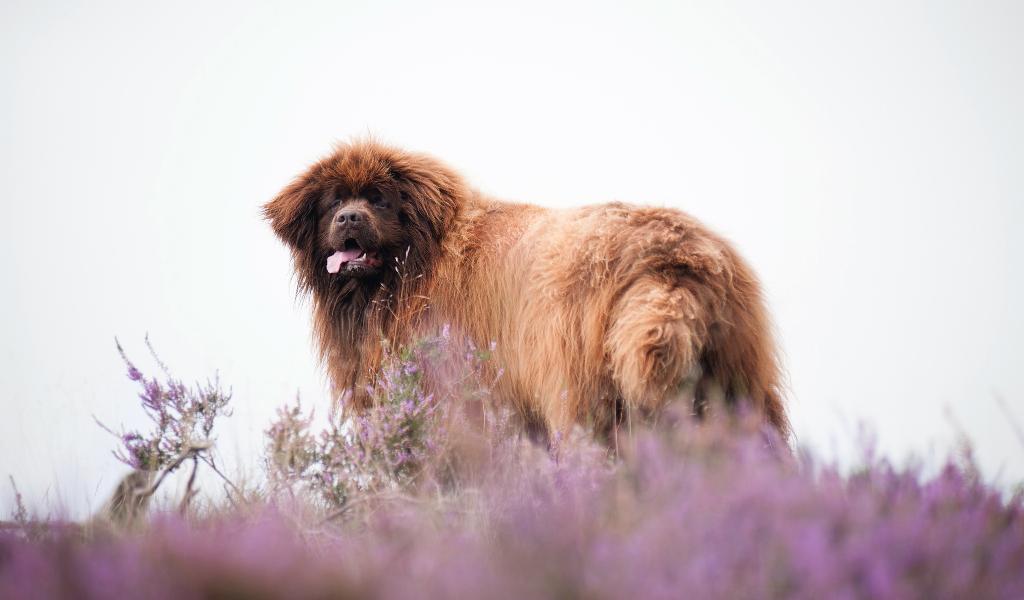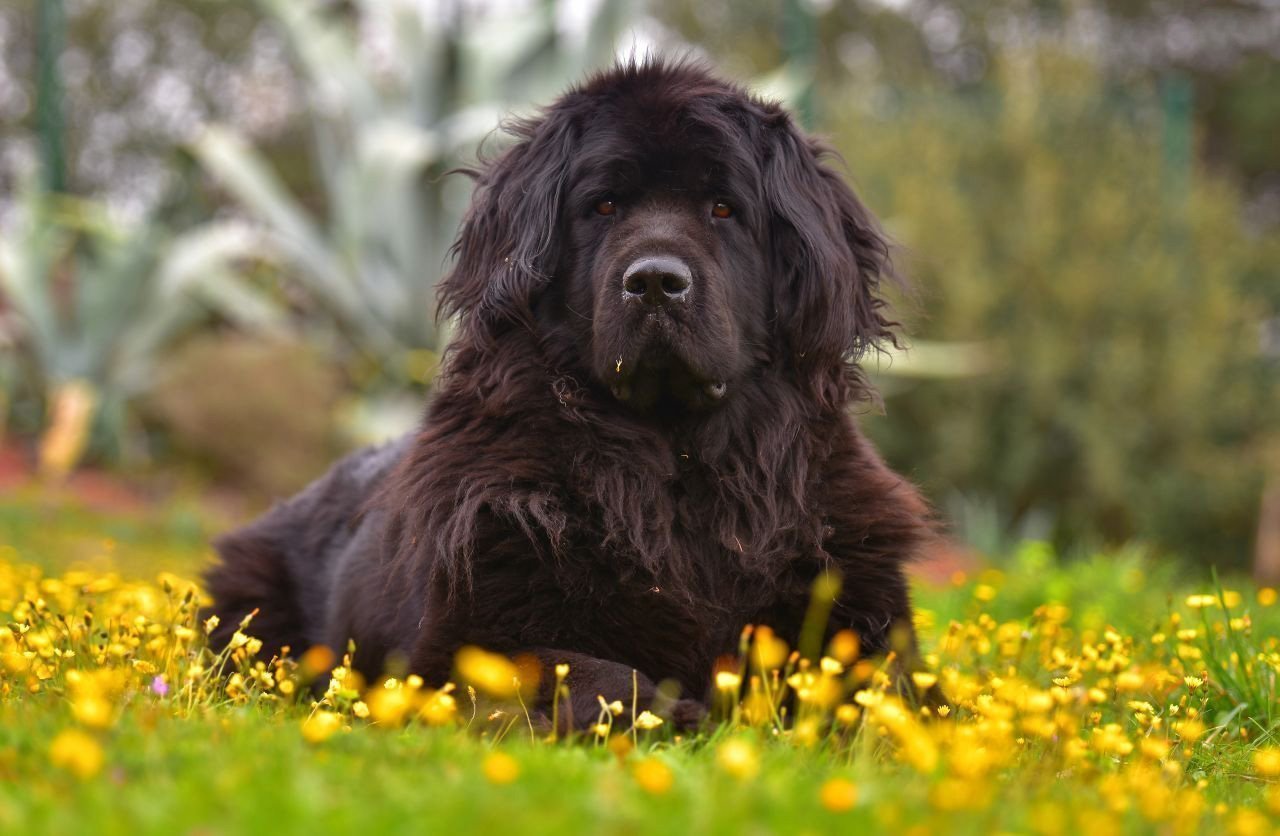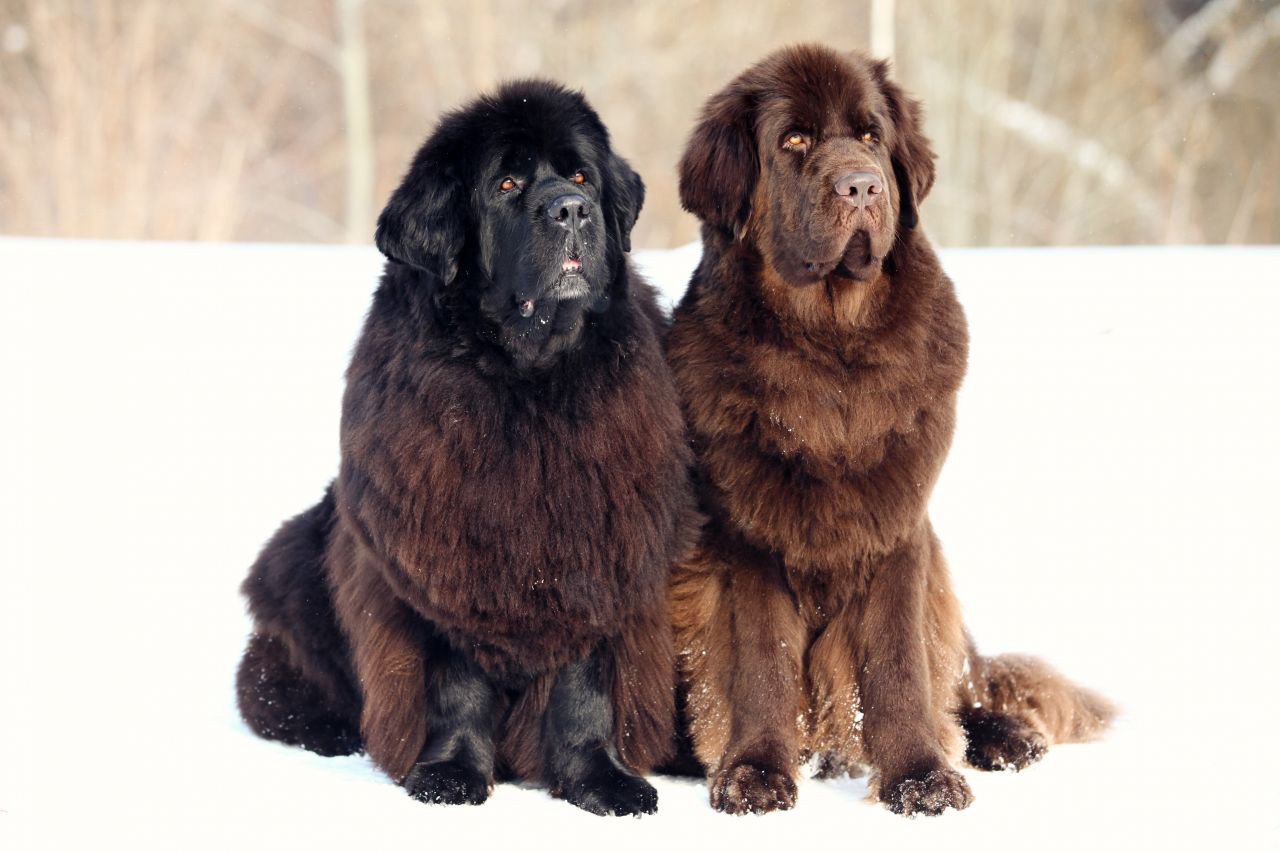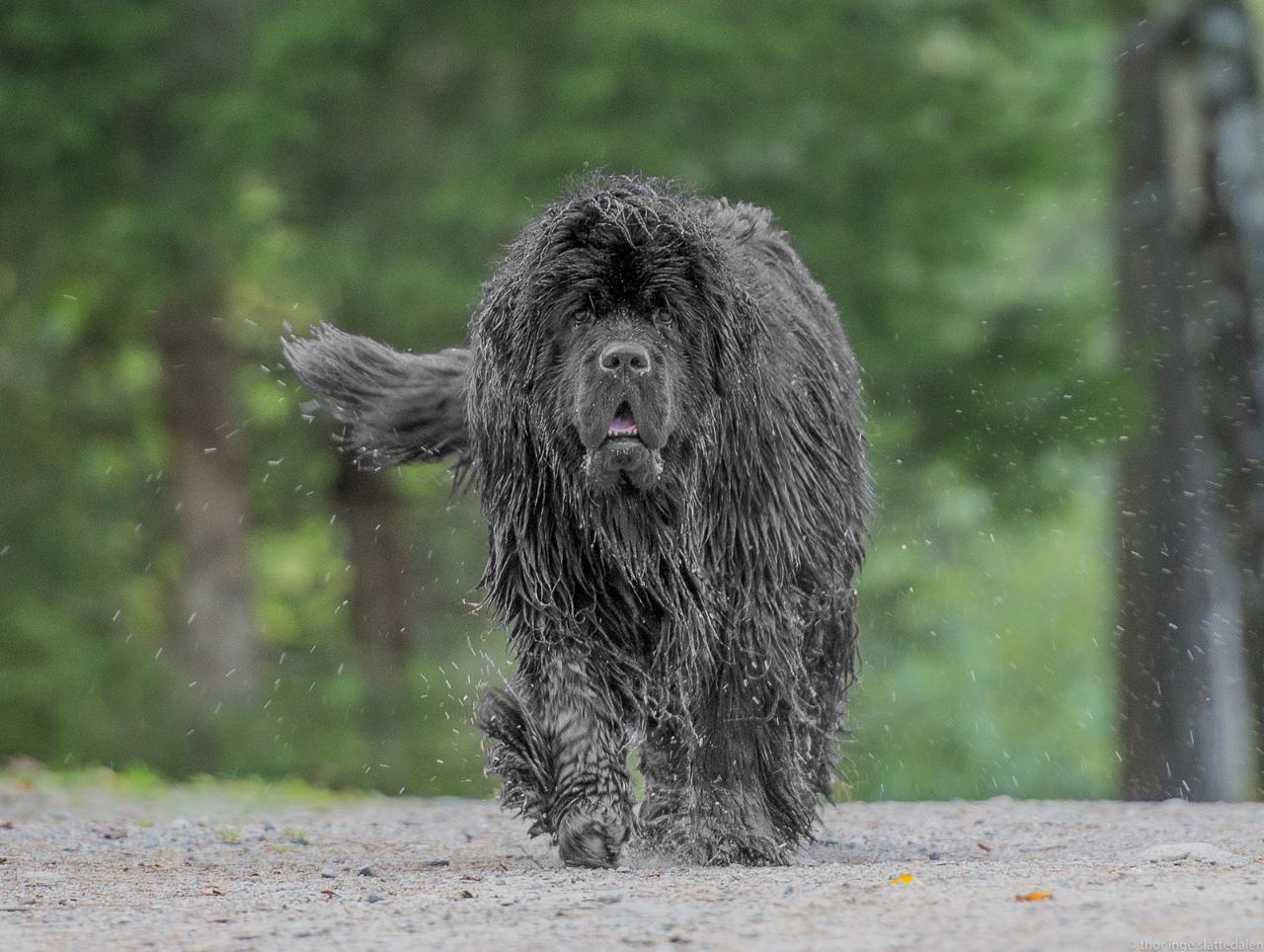The Newfoundland is a huge powerful dog with a spectacular appearance and great temperament. Its purpose is to serve people.
Newfoundland is a dog that cannot be passed by without a smile. Its powerful forms and “bearish”, somewhat frightening appearance are not able to hide a generous heart and kind disposition. Excellent character, self-esteem, incredible kindness, devotion, courage, expressive majestic appearance – those virtues that brought these dogs worldwide fame. They are the heroes of many literary works, reports, participants in dangerous expeditions and hostilities. Newfoundland in the family is always an inexhaustible source of joy, warmth, and love.

History of the Newfoundland breed
The birthplace of the breed, which shared the name with it, is the island of Newfoundland, located off the east coast of North America and belonging to Canada. There are many legends about the origin of these dogs, and many of them, quite possibly, is not so far from the truth.
Some dog handlers suggest that the ancestors of the Newfoundlands are Berenbeitsers, common in medieval Europe pickling dogs – “Medvedeborts”, who are also considered the progenitors of mastiffs. These powerful dogs allegedly ended up on the island with a Viking team led by the Scandinavian sailor Leif Eriksson on a ship that arrived on the coast of Newfoundland around 1000. Subsequently, the descendants of these animals went wild. When Europeans reappeared here in the 16th century, they were amazed at the sight of huge black and shaggy dogs that they met here.
According to the famous Swiss dog handler, Professor Albert Heim, who specialized in the study of Newfoundlands, these animals descended from the Molossians, massive dog-like dogs of the so-called mastiff type, brought to the island by the British during the period of its colonization.
There is an opinion that among the ancestors of the Newfoundlands there are large black-and-piebald shepherds, who also got overseas from the European continent. White Pyrenean mountain dogs are also mentioned, which could have been brought to North America by Spanish and Portuguese settlers. It is believed that it was thanks to them that the black and white color of the Newfoundlands arose.
Some dog handlers suggest that the formation of the breed was not without the aboriginal representatives of the canine tribe. Presumably, already in the XI century, indigenous tribes lived on the island, who were the descendants of the Paleo-Eskimo peoples, whose companions and assistants were sled dogs. Perhaps it was from them that the Newfoundlands inherited their friendly disposition and determination to come to the aid of a person under any circumstances.
The first descriptions of dogs from the island of Newfoundland began to appear at the dawn of the 18th century. Two types of them were known: “The Little Dog of St. John” and “The Big Dog of St. John”. “St. John” or “St. John’s” – the name of the largest settlement on the island at that time, today – the main city of the Canadian province of Newfoundland. The descriptions noted the excellent working qualities of these dogs, their good-natured nature, as well as the ability to dive deeply and swim far. The British began to take dogs from the island and soon began to systematically select them. The first type was used in breeding the breed of retrievers, and the second became known as the Newfoundland. According to some reports, for the first time, in 1775, George Cartwright named his dog Newfoundland.
Initially, English breeders selected black and white dogs for mating, later named Landseers in honor of the British painter Edwin Henry Landseer. He loved to portray such dogs on his canvases. However, over time, breeders began to give preference to animals with a solid black color.
In the middle of the 19th century, a fashion for large representatives of the canine tribe arose in Great Britain. At exhibitions in 1860 and 1862, held in Birmingham, dogs from the island of Newfoundland made a splash, and in 1864 a dog belonging to the Prince of Wales himself took first place at the Birmingham show. In 1878, the first Newfoundland was entered into the studbook of the English Kennel Club – the oldest kennel club in the world, and a year later a breed standard was developed. Gorgeous mighty dogs began to rapidly gain popularity in Europe, and in 1885 the first Newfoundland lovers’ club was founded in the United States. Today, in renowned cynological clubs in Europe and the United States, you can buy Newfoundland puppies, leading their official pedigree since the 80s of the last century.
At the beginning of the 20th century, Newfoundlands gained popularity among Russian aristocrats, but the fashion for them did not acquire a mass character. In the 40-50s, representatives of this breed were actively exported from Germany in the USSR. At the Krasnaya Zvezda nursery of the Ministry of Defense, breeders worked to improve the working qualities of the Newfoundlands. They were crossed with German and Caucasian shepherd dogs, trying to give the dogs aggressiveness and at the same time preserve the instincts of a rescuer in them. These experiments failed, like the dogs, instead of helping the person, showed aggression towards him. The Newfoundlands also did not succeed in guard duty. In the 80s, breeding work on the development of a new breed was discontinued, although it managed to get its own name – the Moscow diver.
Since the mid-1980s, breeding of imported Newfoundlands began in Russia, and Moscow divers gradually “disappeared” into their livestock. They are remembered by the pedigrees of a small number of domestic Newfoundlands and the tradition to call this breed of dogs divers. Newfoundlands are also often referred to as New fathers.
Newfoundland appearance
Newfoundland is a mighty dog of athletic build, whose fur resembles a luxurious boyar coat. The huge size of the dog does not make it clumsy and clumsy. On the contrary, they have excellent control over their own body and look quite graceful. Male dogs can weigh up to 70 kg, females up to 55 kg.
Housing
The body of the Newfoundland is strong, dense, compact. Length of body from withers to the base of the tail is identical to length from withers to floor. The back and croup are wide, solid, the loin is strong, muscular, the chest is powerful. The lower chest line of the abdomen is almost flat. In females the body is often more elongated and not as massive as in males.
Head
Large, heavy, with a wide skull with a slightly protruding vault. The occipital protuberance is well developed. A stop is distinguishable, but it is not excessively sharp. The relatively short muzzle of the Newfoundland has a square shape, it is covered with short soft fur. There are no skin folds on the face. The corners of the mouth are clearly pronounced. The cheeks are soft. The nostrils are well developed. The color of the nose is distinct. In black and white and black dogs, it is black, and in brown dogs it is brown.
Jaws and teeth
The jaws are powerful. The teeth look impressive: they are large, white, with pronounced canines. Scissor or straight bite.
Eyes
Small, set deep, and at a fairly wide distance from each other. The eyelids should not droop and expose the reddish conjunctiva. Black and black-and-white Newfoundlands should have dark brown eyes; brown animals may have a lighter tint.
Ears
The ears of the Newfoundland are small, set closer to the back of the head, have a triangular shape, and are rounded at the tips. If the ear of an adult Newfoundland is pulled forward, its end should reach the inner corner of the eye, which is on the same side of the head.
Neck
Powerful, muscular, without pronounced dewlap. It is long enough to provide a majestic head fit.
Limbs
The front legs of the Newfoundland should be straight. They remain parallel in those cases when the dog walks measuredly or moves at a leisurely trot. The brachial muscular system is well developed, the shoulders themselves are set back. The pasterns are slightly sloping. The hind legs are expressively powerful, with excellently developed femoral muscles. The legs are strong, elongated. The hind pasterns are short, set low and wide, parallel to each other, protruding neither in nor out. The feet of the Newfoundland paws are large, in proportion to the body. They are rounded and appear to be gathered into a lump. The fingers are firm, compact, tightly closed, they are connected by the swimming membranes. The claws of black and black-and-white divers are black; brown dogs are characterized by horny claws. If the dog has profitable toes, they should be removed.
Tail
The tail of the Newfoundland is thick, wide at its base. When the dog is swimming, it acts as a rudder. In a standing animal, the tail is slightly lowered, a slight bend is noticeable at its end, it descends approximately to the hock joint, sometimes slightly lower. When the animal is in motion or playfully tuned, the tail is held high, then it is slightly curved upward. The tail is not allowed to be thrown over the back or tucked between the legs.
Traffic
Newfoundland moves with boldness, showing tirelessness and power. The back remains level during movement. In the process of running, as the speed increases, the dog tries to place its paws closer to the midline.
Wool
Both the coat and the undercoat of the Newfoundland are oily, waterproof, smooth, thick, and have a tough structure. Wool has a water repellent effect. The guard hair is quite long and straight, there are no curls, but slight waviness is acceptable. The soft, dense undercoat becomes even denser in winter, especially in the croup and chest area. The dog’s tail is covered with long thick hair, the head, muzzle, and ears are short and soft. The limbs are decorated with feathers.
Color
The classic color is black. The color should be as intense as possible; when fading in the sun, a brownish tint is acceptable. For the brown color of Newfoundland, shades are allowed: from chocolate to bronze. With these two monochrome colors, white markings on the chest, fingers, tip of the tail are acceptable.
For black-and-white color, the following option is most preferable: a black head with a white blaze that descends on the muzzle, black spots on the saddle, in the region of the croup, and the base of the tail. The dominant cover should be white.
Disadvantages
- Lightweight body with lightweight boning giving an impression of looseness.
- Hunched, soft, or drooping back.
- Pointed or simply elongated muzzle.
- Round or rolling eyes, their yellow color, conjunctiva.
- High limbs. Weak pasterns, loose legs on the front legs, straight knee angles and turned inward legs on the hind legs. Lack of membranes connecting the fingers.
- Excessively short or elongated tail, or curling at the end.
- Mincing, shuffling or unsteady gait, sideways movement, short stride, the crossing of the forelimbs during movement.

Newfoundland personality
Newfoundland is called a “golden” dog. He is kind, loyal, friendly, tactful, not at all inclined to aggression. Using the terminology of psychics, we can say that he has a good biofield. The very presence of this good-natured giant in the house creates an atmosphere of comfort, security, and benevolence.
Perhaps the Newfoundlands are the most socialized dogs in the world, the main purpose of their existence is to serve humans. They are selflessly heroic and ready to help at any moment. They are completely devoted to the work entrusted to them – whether it be a police or military mission, escorting the blind, and even transporting goods. No wonder one of the paintings of the British artist Edwin Henry Landseer, which depicts Newfoundland in all its glory, is called “A Worthy Member of Human Society.”
Divers demonstrate their excellent character traits from early childhood. The kids are not at all capricious, they quickly become attached to the owner, but they do not get bored, demanding increased attention to themselves, they do not whine, and do not bark for no reason.
Adult dogs are incredibly smart and practical. You can even say that they have an analytical mind and have their own opinion on any issue. Commands that seem meaningless to them, they can simply ignore or execute in their own way. But to rush to help the drowning man, this dog does not need a command at all – it will selflessly throw itself into the water in any case. Clearly and confidently Newfoundlands act in dangerous situations, for this, they also do not need special instructions. Actually, the innate quick wits and the ability to independently and quickly make the right decision under the circumstances is a distinctive feature of the outstanding intelligence of these animals.
Newfoundlands are well versed in the intonation of the human voice and can easily determine what mood the owner is in. They understand when they need to be supported by being around, or are removed from sight. Very polite by nature, Newfoundlands are very sensitive to being rude towards themselves. The dog, like a person, takes offense when they shout at him, and after a quarrel for a while he withdraws into himself, refusing to communicate with the offender.
Newfoundlands are not the best watchmen, since all people are initially friendly and open to communication. One should not expect an instant aggressive reaction to a stranger from them, since these dogs are not inclined to harsh and thoughtless actions, and they need some time to analyze the situation. Sensing danger, they first warn the enemy with a formidable bark, and then fiercely attack him with all their remarkable power.
Newfoundlands love family picnic outings. In the car, they behave decorously and do not worry. Playing in nature, especially near water bodies, where they can swim to their fullest, bring incredible pleasure to these dogs. Parents can be calm for their babies if there is a vigilant Newfoundland next to them. He will gladly take part in children’s fun, but he will stop risky pranks – he will independently or with a loud bark notify others about the danger.
Newfoundland is a monogamous dog. Having given his heart to one family, he will forever remain faithful to her. Having changed the owners for some reason, the dog will be polite to them, but he will not be able to get rid of the longing for his home. It will be difficult for new owners to establish a trusting relationship with such a pet.
Education and training
Newfoundland’s comprehension and excellent memory make routine workouts an enjoyable pastime. The dog catches everything on the fly and often, not having listened to the task to the end, starts up to carry it out. Commands to this dog should be given in a calm tone, without raising his voice. She simply will not react to demanding orders and shouts. Actually, this is not required: it is enough for a Newfoundland to ask for something politely and gently, and he will readily respond to any request.
Care and maintenance
Newfoundlands feel great both in nature and in urban settings: they are not afraid of either busy streets or traffic. Small-sized apartments are not the best place to live for these giants, but medium-sized housing is quite suitable for them because dogs with a calm disposition do not have the habit of running around the apartment, sweeping away everything around. In a Newfoundland house, there should be a place where he will sleep or just relax. It is desirable that it be spacious and has an orthopedic base, for example, it can be a small mattress. It should be covered with a cloth that can be easily washed, as these dogs salivate profusely.
Newfoundlands do not differ in agility and tend to passive pastime, but they need physical activity. These dogs should be walked at least twice a day, preferably in the morning and evening.
An ideal place to keep a Newfoundland is a country house, near which there is a pond, lake, or river. An open-air cage is not suitable for a diver – deprived of communication with people, he will yearn. Moreover, you cannot put him on a chain.
The thick coat of the Newfoundland requires systematic grooming. Brushing your dog should be at least three times a week with a stiff brush, otherwise, its coat will fumble and form tangles that can poison your dog’s life, causing itching. If a mug has already formed, it is better to unravel it. Cut them out in extreme, completely neglected cases. Twice a year, in autumn and spring, the undercoat of the Newfoundlands is renewed. During this period, the dog needs to be combed every day. To help your pet, you can also contact a grooming master who will carry out a facilitating haircut.
Newfoundlands do not require frequent baths, because their wool, impregnated with natural lubricant, itself repels dirt and water. The use of shampoos is very bad for the condition of the coat.
Newfoundland nails should be trimmed once a month. It is required to monitor the ears and eyes, systematically checking them for the presence of secretions that may indicate an infectious disease. Periodically, the ears and eyes should be wiped with a damp cloth.
Feeding Newfoundlands should be taken seriously. It should be balanced, abundant, but in moderation, since these dogs are prone to obesity.
When fed naturally, the dog’s diet should include the following foods:
- veal, beef, lamb, rabbit meat (50% of the total amount of products). It is not recommended to feed them with pork and poultry;
- from cereals – oatmeal and buckwheat, and it is better to exclude rice, pearl barley, millet;
- sea fish – raw or boiled, river fish – exclusively boiled;
- cottage cheese;
- carrots, in small quantities – beets and cabbage, scalded with boiling water parsley, nettle, dill, lettuce;
- bread in the form of croutons.
Potatoes, spicy and smoked foods, sweets, especially chocolate are prohibited in feed.
Newfoundland diets can include ready-made, high-quality super-premium and holistic foods.
Puppies should be fed 5 times a day, and the number of feeds decreases as they get older. For adult dogs, it is sufficient to give food twice a day.

Newfoundland health and disease
Several diseases are characteristic of Newfoundlands, both common to all dogs and characteristic of this particular breed. Their massiveness creates problems for the musculoskeletal system, they often develop arthritis and hip dysplasia. A sedentary lifestyle, lack of activity can lead to obesity and, as a result, heart disease.
A native of the north, Newfoundland suffers from heat and may well get heatstroke. Its main symptoms are lethargy, dry warm nose, lack of appetite. On hot days, you need to make sure that the dog always has water in the bowl. In no case should you leave the dog in a closed car? In the summer, it is advisable to provide the diver with the opportunity to swim more often.

How to choose a puppy?
Newfoundland puppies certainly need to be bought from a kennel or from a breeder whose integrity you are sure of. In this case, you will have guarantees that the baby is thoroughbred and has all the necessary vaccinations. In the kennel, you will be able to meet his mother, and, if you’re lucky, even with his father. This will allow you to get an idea of what your grown “bear” will look like.
According to the RKF rules, breeders have the right to sell puppies after they turn 45 days old. But many people prefer to buy babies who have already received all the vaccinations, that is, at the age of 3-3.5 months. In this case, it will already be possible to walk them without fear. Those who want to buy a puppy for breeding should wait until he is 6-9 months old when the features of his anatomy and behavior will be obvious.
A small Newfoundland should have a well-proportioned physique and be a tiny replica of an adult dog. A puppy is supposed to be active, curious, moderately well-fed. His coat should be shiny and clean, without tangles, and the bite should be correct.

